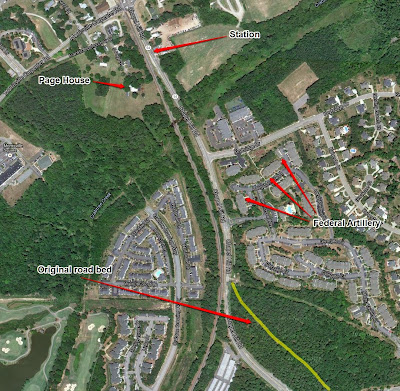You're looking at a unique piece of history which, after surviving for 148 years after the Civil War, is now gone forever.
The photo above shows the original 19th century road bed approaching the city of Morrisville, North Carolina. A few weeks ago, it was exposed by construction, the surrounding slopes denuded of trees for the first time in over a century, providing an all-too-brief opportunity to see in broad, 21st century daylight, a road almost untouched since the time of the War.
In fact, this was the very road used by General Judson Kilpatrick's cavalry during their attack on Morrisville Station from April 13 -15, 1865. They followed the road pictured above, traveling from the top of the hill down the slope to the foreground of the image. From there, they would have had their first sight of Morrisville Station itself just across Crabtree Creek, its rail yards filled with cars loaded full of troop supplies and Confederate wounded.
Kilpatrick's reaction on seeing the cars was to quickly unlimber his guns and proceed to shell the station, with questionable accuracy as it turned out. Today, the chimney of the Page House in Morrisville, about 60 meters west of the tracks, still bears the scars from some of those shells.
 |
| Map showing path of original road, artillery position, and the Page House. |
It didn't take long for Johnston to get his troops and supplies moving once the shells started falling and the trains pulled out of Morrisville and steamed away for Greensboro. Afterwards, the Federals made Morrisville their camp and it was while encamped there that an envoy from Johnston approached with the proposal to discuss terms of surrender which subsequently occurred at the Bennet House near Durham Station.
The Battle of Morrisville Station was the the last large scale engagement of the Civil War —literally the last in which cannon were fired. Never again were they heard after that day in Morrisville in 1865.
Look at these pictures —these roads felt the hooves and footsteps of soldiers marching into battle. They heard the crackle of musketry and trembled with the concussion of cannon fire. They saw the sun and the stars for over 150 years and, for a few days in 2013, were open once more to the bright Carolina skies. Now they are gone forever like the men who marched on and slept by them in those long ago days of summer.
 |
| Note how deep the 19th century road was. Direction of march in this image was foreground to background. |
With each passing day more of the 19th century succumbs to modern development. We can attempt to preserve it with an image here or a relic there or a blog such as this. But history is ephemeral and of interest to fewer and fewer it seems in today's materialistic society.
 |
| A bullet dropped by Kilpatrick's troops as they moved on Morrisville. |
Whether cognizant of history or not, it remains with us today sometimes right under our noses. That's one aspect of what makes relic hunting so interesting for me. —discovering things, sometimes standing out in plain sight, that others don't see. Most folks living in Morrisville probably never saw the old road over which Kilpatrick's forces rode en route to attacking their town.
 |
| General Judson Kilpatrick |
In April 1865, Kilpatrick invaded Morrisville. Today, chances are that Judson Kilpatrick's great, great grandson invades your living room every day! He is none other than CNN's Anderson Cooper who bears more than a passing resemblance to the notorious General although to my knowledge he's never visited Morrisville.









